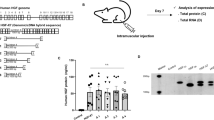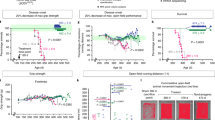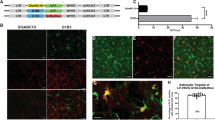Abstract
Herpes simplex virus has been extensively genetically modified for gene transfer to nerve and other tissues, to create vectors that are devoid of viral gene expression and toxicity. Recombinant vectors have been engineered to express genes which protect neurons against toxic insults resulting in cell death, including nerve growth factor (NGF) and anti-apoptotic genes (eg bcl-2). This review describes experiments using HSV vectors expressing these gene products and their potential protective role in ameliorating neurodegenerative processes in animal model systems.
This is a preview of subscription content, access via your institution
Access options
Subscribe to this journal
Receive 12 print issues and online access
$259.00 per year
only $21.58 per issue
Buy this article
- Purchase on Springer Link
- Instant access to full article PDF
Prices may be subject to local taxes which are calculated during checkout



Similar content being viewed by others
References
Fink D et al. Gene transfer to neurons using herpes simplex virus-based vectors Ann Rev Neurosci 1996 19: 265–287
Roizman B, Sears A . Herpes simplex viruses and their replication. In: Fields BN et al (eds) Fields Virology, vol. 2 Raven Press: Philadelphia 1996 pp 2231–2295
Herold B et al. Glycoprotein C-independent binding of herpes simplex virus to cells requires cell surface heparan sulfate and glycoprotein B J Gen Virol 1994 75: 1211–1222
Tal-Singer R et al. Interaction of herpes simplex virus glycoprotein gC with mammalian cell surface molecules J Virol 1995 69: 4471–4483
Montgomery RI et al. Herpes simplex virus 1 entry into cells mediated by a novel member of the TNF/NGF receptor family Cell 1996 87: 427–436
Geraghty RJ et al. Entry of alpha herpes viruses mediated by poliovirus receptor-related protein 1 and poliovirus receptor Science 1998 280: 1618–1620
Dixon RAF, Schaffer PA . Fine-structure mapping and functional analysis of temperature-sensitive mutants in the gene encoding the herpes simplex virus type 1 immediate early protein VP175 J Virol 1980 36: 189–203
Preston C . Control of herpes simplex virus type 1 mRNA synthesis in cells infected with wild-type virus or the temperature-sensitive mutant tsK J Virol 1979 29: 275–284
DeLuca NA, McCarthy AM, Schaffer PA . Isolation and characterization of deletion mutants of herpes simplex virus type 1 in the gene encoding immediate–early regulatory protein ICP4 J Virol 1985 56: 558–570
Samaniego LA, Neiderhiser L, DeLuca NA . Persistence and expression of the herpes simplex virus genome in the absence of immediate–early proteins J Virol 1998 72: 3307–3320
Wu N et al. Prolonged gene expression and cell survival after infection by a herpes simplex virus mutant defective in the immediate–early genes encoding ICP4, ICP27, and ICP22 J Virol 1996 70: 6358–6368
Hobbs W, DeLuca N . Perturbation of cell cycle progression and cellular gene expression as a function of herpes simplex virus ICP0 J Virol 1999 73: 8245–8255
Wrzoa H, Rapp F . Establishment of latency in vitro with herpes simplex virus temperature-sensitive mutants at nonpermissive temperature Virus Res 1987 8: 301–308
Spivack JG, Fraser NW . Detection of herpes simplex virus type 1 transcripts during latent infection in mice J Virol 1987 61: 3841–3847
Spivack J, Fraser N . Expression of herpes simplex virus type 1 latency-associated transcripts in trigeminal ganglia of mice during acute infection and reactivation of latent infection J Virol 1988 62: 1479–1485
Ramakrishnan R et al. Competitive quantitative polymerase chain reaction (PCR) analysis of herpes simplex virus type 1 DNA and LAT RNA in latently infected cells of the rat brain J Virol 1994 68: 1864–1870
Ramakrishnan R et al. Detection of herpes simplex virus type 1 latency-associated transcript expression in trigeminal ganglia by in situ reverse transcriptase PCR J Virol 1996 70: 6519–6523
Goins WF et al. Herpes simplex virus type 1 vector-mediated expression of nerve growth factor protects dorsal root ganglia neurons from peroxide toxicity J Virol 1999 73: 519–532
Wolfe DP et al. Long term systemic delivery of nerve growth factor for treatment of peripheral neuropathies using replication defective genomic HSV vectors Soc Neurosci Abstr 1999 25: 2279
Yamada M et al. HSV vector-mediated expression of Bcl-2 prevents 6-hydroxydopamine induced degeneration of neurons in the substantia nigra in vivo Proc Natl Acad Sci USA 1999 96: 4078–4083
Acknowledgements
This work was supported by grants from the NIH (5R01EY11528-03), (2R01CA66141-10A2), (5R01AR4452603) Department of Veterans Affairs and US Army (USAMRC 98292035), (DAMD179818626).
Author information
Authors and Affiliations
Rights and permissions
About this article
Cite this article
Fink, D., DeLuca, N., Yamada, M. et al. Design and application of HSV vectors for neuroprotection. Gene Ther 7, 115–119 (2000). https://doi.org/10.1038/sj.gt.3301118
Published:
Issue Date:
DOI: https://doi.org/10.1038/sj.gt.3301118
Keywords
This article is cited by
-
Gene therapy for the treatment of diabetic neuropathy
Current Diabetes Reports (2008)
-
Neuroprotective gene therapy against acute neurological insults
Nature Reviews Neuroscience (2003)
-
Viral oncoapoptosis of human tumor cells
Gene Therapy (2003)
-
Immune responses to replication-defective HSV-1 type vectors within the CNS: implications for gene therapy
Gene Therapy (2003)
-
Viruses as gene delivery vectors: Application to gene function, target validation, and assay development
Cancer Gene Therapy (2002)



